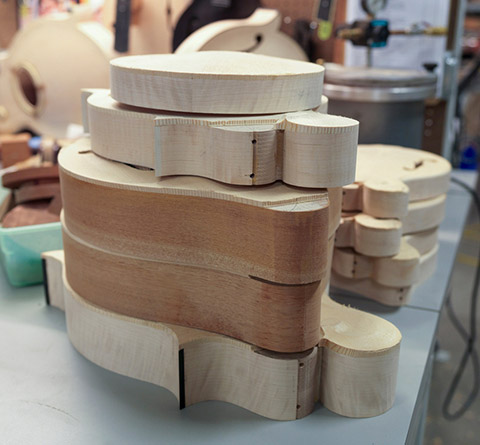Mandolin Body Shapes and Sound Holes
Mar 21, 2018, Weber News

By Michael Eck
The simple fact of the matter is that you can play anything you want on your Weber mandolin, regardless of which you’ve chosen. If your hands are ready and you’ve done your homework and you have the right attitude, you can play jazz, bluegrass, folk, klezmer, classical, whatever you please.
But it’s also true that certain body shapes and sound hole configurations lend themselves to specific musical modes, and tradition, too, plays a hand in how your eye hears the music you play.
The F shape has long been the ne plus ultra of the mandolin world, and it’s easy to see why. It’s just the most lovely thing, isn’t it? Shapely, perfectly proportioned, it’s almost profound, the attraction of an F style mandolin.
The classic F brandishes its two points with a flourish. The Florentine scroll (which is where the F designation comes from) sits across, its sensual curve off-setting those wings. Its long, slim neck is topped with a riff on the body, more curlicues and daggers.
“It’s got that nice percussive sound, and it’s a really beautiful design,” says Weber luthier Ryan Fish.
But beyond the beauty, the F body is also remarkably balanced as an instrument, as a musical tool. The scroll, it turns out, is the perfect straphanger. The upper point informs the left hand as it reaches for the sonic stratosphere of the upper frets, while the lower, when seated, acts as a perfect fulcrum against the thigh.
Tonewise, Fish, who stays up late studying this stuff, is convinced the extra mass of the maple headblock on an F style firms up the sound, giving weight to the distinctive midrange bark so associated with Weber mandolins. That chop is, of course, what makes the F mandolin the perfect, endlessly expressive bluegrass vehicle.
“The added material in the scroll and neck joint definitely contributes to the timbre,” Fish opines, “adding some extra sustain and opening up the air chamber a little bit, for kind of a deeper sound. Everything makes an impact, and that wood stiffens and supports the top.”
What about a Heritage Series Vintage F14-O? Is that a bluegrass machine like a Fern or Diamondback? As noted, you can make every kind of music on any Weber, but the oval sound hole of the Vintage is more associated with old time, Celtic and jazzier styles.
“An oval hole has a richness to it, with a lot of nice overtones and sustain,” says Fish. “It’s a sweeter, mellower sound, great for melody playing. But there’s not as much difference between the varied body and sound hole styles as is often generalized.”
When Bill Monroe chose an F style, he also made sure it boasted F-holes. As he invented bluegrass, he knew that he wanted to sing higher and play faster than his fellow country musicians. But he also knew that he wanted his bluesy, skittering eighth notes to blast through the banjo and guitar.
F-holes generate sound in a fundamentally different way than oval holes, Fish says, throwing waves forward from the player and his box, towards the audience.
“F holes are perceptibly louder and punchier, they cut right through a mix,” he notes.
Neither is better. It’s a choice, and one that can be as important to the dedicated hobbyist entertaining themself and a few friends around the campfire as it is to a touring professional picking in front of a microphone in a new city every evening.
Intrinsically, an F mandolin and an A model are close cousins. The sound chamber is virtually identical, with the solid blocks inside the scroll and points of an F making it similar in inner dimensions. All models in the current Weber line receive hand-voicing and deflection monitoring as well.
“A bodies feature mahogany headblocks,” Fish adds, “and those definitely have an individual sound.”
Perhaps the bigger contrasts are found in the look and feel of an A (particularly when comparing matching sound hole choices).
The A, Fish says, boasts its own appeal.
“Some people like that simpler aesthetic, and the A body has some special warmth to it.”
Its symmetry is as lovely in its austerity as the F is in its flash; and custom two- and three-point options can split the difference visually.
Fish points out that the tonal qualities in the oval hole and f-hole options of Weber mandolins stem as much from their respective bracing patterns as from any other variable, including dovetail, mortise and tenon or finish.
All Weber f-holes are tone bar braced, while oval hole editions are X-braced, with the latter opening up quickly and the former offering great rewards over time.
“The X-bracing comes to life right away,” Fish affirms, “and some players want that. The tone bars may take a little longer to open up, but they sound really great when they do!”
A or F body, oval or f-shaped sound holes. The choice is yours. You won’t be disappointed either way.
